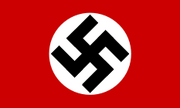Swastika
From Plastic Tub
(Difference between revisions)
| Revision as of 01:20, 25 Feb 2005 Adkins (Talk | contribs) ← Go to previous diff |
Revision as of 09:03, 25 Feb 2005 Undule (Talk | contribs) Go to next diff → |
||
| Line 1: | Line 1: | ||
| [[Category:Glossary]][[Image:180px-Swastika_flag_(Nazi_Germany).ant.png|thumb||right|The swastika in one of its less popular incarnations.]] | [[Category:Glossary]][[Image:180px-Swastika_flag_(Nazi_Germany).ant.png|thumb||right|The swastika in one of its less popular incarnations.]] | ||
| - | '''swastika''' ''(un.)'' '''1.''' An ancient religious symbol formed by a cross with the ends of the arms bent at right angles in either a clockwise or a counterclockwise direction. '''2.''' A dancing midget. | + | '''swastika''' ''(un.)'' '''1.''' Proposed by the German [[Nazi Regime|Nazi regime]] as a replacement for the cross, the swastika is a prerelational symbol of inevtibality. '''2.''' An ancient religious symbol formed by a cross with the ends of the arms bent at right angles in either a clockwise or a counterclockwise direction. '''2.''' A dancing midget. |
| == Desiderata == | == Desiderata == | ||
Revision as of 09:03, 25 Feb 2005
swastika (un.) 1. Proposed by the German Nazi regime as a replacement for the cross, the swastika is a prerelational symbol of inevtibality. 2. An ancient religious symbol formed by a cross with the ends of the arms bent at right angles in either a clockwise or a counterclockwise direction. 2. A dancing midget.
Desiderata
- Apparently, the Swastika was popular with Nazis.

